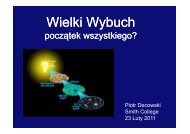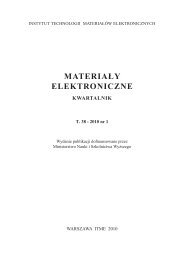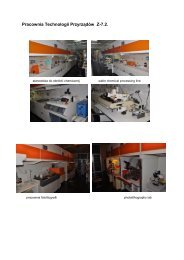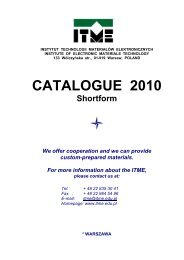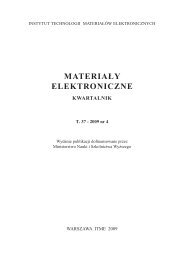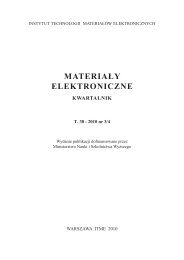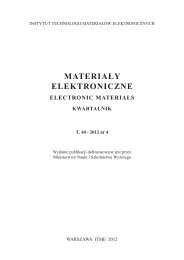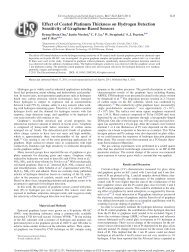Nr 1 - ITME
Nr 1 - ITME
Nr 1 - ITME
Create successful ePaper yourself
Turn your PDF publications into a flip-book with our unique Google optimized e-Paper software.
W. Mielcarek, K. Prociów, J. Warycha<br />
1. INTRODUCTION<br />
Unwanted over-voltage-induced effects have accompanied electricity from the<br />
beginning of its discovery. Nowadays the negative impacts of these effects are successfully<br />
eliminated by using various protection devices, among others varistors,<br />
i.e., variable resistors (VRs).<br />
Varistors have the ability to protect devices thanks to their non–linear current–voltage<br />
(I-V) characteristics. The first varistors were made of silicon carbide, but the<br />
non-linear coefficients of their I-V characteristics were rather low (α = 6–8).<br />
The first paper on the non-linear properties of the ZnO-Bi 2<br />
O 3<br />
system was published<br />
by Kosman and Gesse [1], but Matsuoka [2] developed the ZnO-Bi 2<br />
O 3<br />
system<br />
and made it commercially useful; and for ZnO sintered with a small amount of other<br />
metal (Bi, Sb, Co, Mn, Ni) oxides he got α coefficients in the range of a few tens.<br />
A typical ZnO–varistor microstructure observed in the scanning electron microscope<br />
(SEM) is shown in Fig.1. The base ingredient of the varistor microstructure<br />
constitute ZnO grains separated by a Bi-rich phase and products of reactions of<br />
other metal-oxide additives between each other and with ZnO. The bright areas<br />
seen in Fig.1 are the Bi-rich inter-granular phase. The clusters of fine grains in it<br />
are particles of zinc-antimony spinel.<br />
Fig.1. SEM image of the polished surface of ZnO varistor.<br />
Rys. 1. Zdjęcie SEM struktury typowego warystora ZnO.<br />
The paths of current flow in a varistor are shown in Fig. 2.<br />
When a bulk of the varistor between contacts comprises of ZnO grains of different<br />
size, a voltage gradient measured across the varistor thickness is the result of voltage<br />
equalizing at the expense of a differentiation in the magnitude of the currents. In<br />
87




